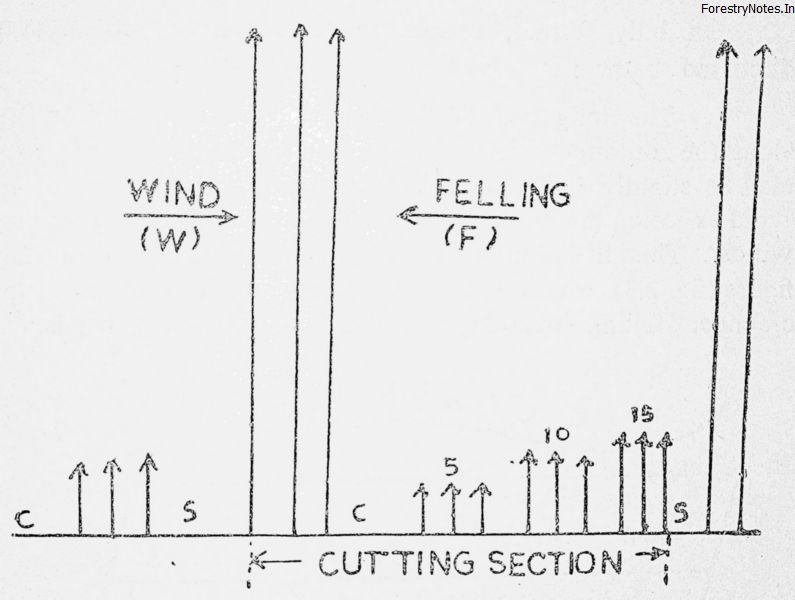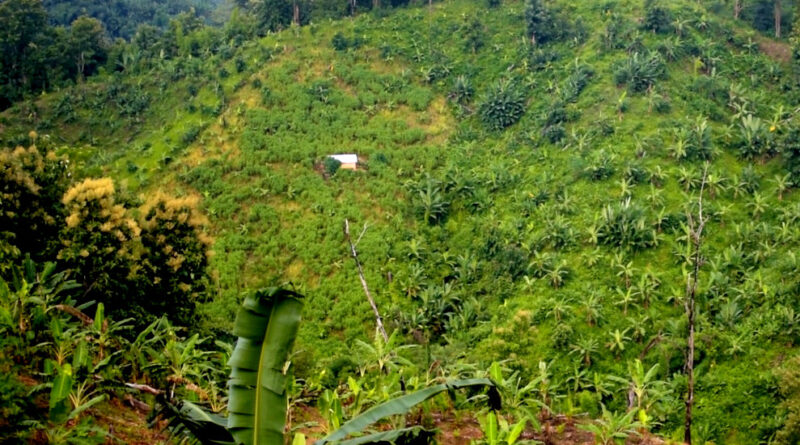Clear Felling System: All You Need To Know
Clear Felling System
The Clear felling System is defined as a Silvicultural System in which equal or equi-productive areas of a mature crop are successively clear-felled in one operation to be regenerated, most frequently, artificially but sometimes naturally also.
But where the area is not equi-productive, larger areas are clear felled on poorer sites so that the annual yield is nearly the same. As clear felling and regeneration work is carried out each year through out the rotation, a normal series of age gradations is formed, unless failure of regeneration in certain years may disturb the series.

Pattern of Felling
The name of the system and its definition given above are sufficient to clarify the pattern of felling of the mature Crop. To describe the pattern of felling unequivocally, it may be stated that in this system the entire mature crop of the coupe or compartment is felled in one operation leaving nothing of the previous crop. However, in practice, following variations are observed :
(i) Retention of some mature trees as a frost protection measure or as insurance against fire and any other adverse climatic factor.
(ii) Retention of promising groups of sapling and poles to prevent unnecessary sacrifice of immature crop of desired species.
Methods of Obtaining Regeneration
Regeneration is obtained mainly artificial but sometimes, it is obtained naturally as well.
Artificial regeneration is preferred to natural regeneration because of the following advantages :
(i) Artificial regeneration ensures quicker, cheaper in the long run and more certain stocking of the regeneration area.
(ii) It is the only method of regenerating forests clear-felled or destroyed by fire leaving no seed bearers to supply seed for natural regeneration.
(iii) It is the only method by which crop composition can be improved.
(iv) It facilitates introduction of fast growing and high yielding exotics.
(v) It facilitates use of planting material produced by clonal technology.
(vi) It completes regeneration operation quickly and therefore results in considerable economy in cost of formation and better financial return.
(vii) As the new crop is established sooner, the area can be opened to grazing sooner.
Methods of Obtaining Artificial Regeneration
Artificial regeneration is obtained either as departmental plantations or by taungya.
(1) Departmental plantations
These are the plantations raised by the range staff by engaging local labour. For raising such a plantation, the area to be clear-felled in the year is found out from the Working Plan and demarcated on ground. As the mature crop is to be felled, it has to be auctioned. As the contractor may require a working season to clear the area, marking and auction may have to be initiated a year or two before the year to which the coupe is assigned, depending on the area involved, as larger the area the more is the time required in clearing it. After the area is cleared, it is inspected to prepare a treatment map to show what species will be raised in different parts of the area, the method of soil working etc. Then soil working is started and the area is fenced. Sowing is done before the rains start while planting is done when the rains have set in. After this, the plantation is weeded well during the rains and during summer protected against fire.
(2) Taungya
Departmental plantations require a large number of labourers and large sums of money which are often difficult to arrange. This problem is solved by allowing landless labourers to settle down inside the forest in some central place in the form of a village and from there, carry out plantation work in the plots alloted to them along with cultivation of agriculture crops in the inter-spaces of plantation lines. Thus, plantations are raised free of cost in lieu of the concession of raising agricultural crop in the inter-spaces of plantation lines and some area to settle down in the form of a village. This form of raising plantation along with the agriculture crops is known as taungva. The technique of taungya varies from place to place depending on the availability of landless labourers and the acuteness of the problem of landlessness. As a village of landless labourers is established in the above mentioned method, it is called a village taungva. As the basic principle of taungya is the raising forest plantation in conjunction with agricultural crops in the inter-spaces of forest plantation lines, there may be several variations of, taungya method e.g., village taungya, leased taungya, semi taungya etc.
Methods of Obtaining Natural Regeneration
The clear-felled areas may be regenerated naturally when it is absolutely certain that natural regeneration will be obtained in a year or so. Because, if natural regeneration is uncertain and cannot be obtained in a year or so, the clear-felled area will get infested with weeds which will make it difficult for the seed to germinate, besides exposing the area to fire risk.
Natural regeneration can be obtained from seed stored in the area, seed received from outside and from advance growth in the area. Typical example of each of these are described below :
(A) Natural regeneration from seed
For natural regeneration, the area gets seeded either by the seeds of the trees clear-felled in the plot or by the seed of the trees standing outside the plot. The seed of the trees clear-felled in the plot can regenerate the plot only when the seed has long viability and the species is frost-hardy. In India, there is no species, yielding valuable timber, which is regenerated by this method. As regards the seed of the trees standing out-side the plot, it can regenerate the clear-felled area if the seed can be blown by the wind or carried by water and spread over the entire area of the clear-felled plot. Besides, it should have long viability and the species should be frost-hardy. In India, there is only one example of Avecennias in Andhra Pradesh mangrove forests in Kakinada sector where the clear-felled area of coupe is regenerated by seed which drift in the felled coupe during tidal inundation. In order to ensure complete stocking, all advance growth under 2.5 cm in diameter is retained at the time of clear-felling.
(B) Natural regeneration from advance growth
The best way in which a coupe or a compartment can be successfully regenerated is the condition in which the clear-felled coupe or plot may have full stocking of advance growth which is defined as seedlings, saplings and poles of species of the over-wood that have become established naturally in a forest before regeneration fellings have started.
The presence of complete stocking of advance growth is a sure sign of the clear-felled coupe being regenerated from this growth. But if the advance growth has stagnated under the mature crop for years, it cannot give well grown new crop. To utilize it for the purpose it has to be cut back so that it may give clean vigorous new shoots.
Dependence on such coppice does not alter the character of the system from high forest to coppice because the coppice depended in this method is the coppice of advance growth and not the coppice shoots of trees of mature crop clear-felled in the area. This method of regeneration is applicable to some Sal forests of Bihar and Madhya Pradesh
Tending
In clear-felled coupes in which regeneration is not to be obtained by taungya, even though the weeds are destroyed by one or two effective burns given before soil working, they sprung up again by the time sowing or planting is commenced. As weeds affect the growth of seedlings of desired species or even kill them by suppression, the plantations have to be kept clean weeded.
The number of weedings depend upon the rate of growth and density of weeds as well as the rate of growth of forest plants and their mode of raising, e.g., sowing or planting. Thus, while three weedings are required during first year for sowing, only one or two are required for planting. In the first weeding which is started within a week of completion of germination, the weeds are pulled out because they have not firmly established in the soil.
By the time first weeding is completed, weeds appear again in that portion of plantation from which first weeding was started. Therefore, the second weeding has to be started within a month of completion of germination. In this weeding, the weeds have to be cut as they have developed long and stout roots by then.
Besides cutting of weeds, soil is hoed on the entire width of line or strip to reduce evaporation of moisture. After about 2 month of completion of germination, third weeding is carried out. In this weeding, in addition to the operations of second weeding, the plants of the desired species are also thinned to space them out to half their height.


